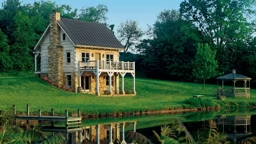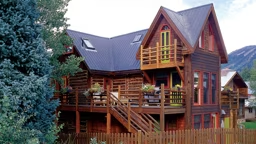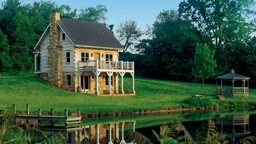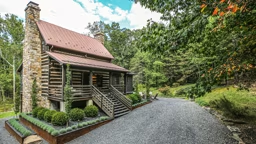 The blend of logs, aspen, and stone give the hand-hewn cabin a rusticity that fits perfectly into the cabin’s natural environment.
The blend of logs, aspen, and stone give the hand-hewn cabin a rusticity that fits perfectly into the cabin’s natural environment.
Hands-On Approach
"When we started, we had absolutely no building experience," Linda states. "I think Tim had built a spice rack at one time," she laughs. What the couple lacked in experience, they made up for in determination. While living in a small shack built with railroad ties, the couple began the building process by cutting down trees and skidding them a mile down the road with an old tractor. "The kids would get on a school bus, then we would cut a few trees," Linda says. "We would get them home just as the kids were getting back." The couple collected 62 logs in all, "mostly spruce with a couple of pine," Linda recalls. Using only hand tools and a chainsaw, the pair hand-peeled, the scribed the logs to ensure each would fit into the contours of the one below to create a handcrafted log cabin. "We took our time, and they've settled quite nicely," Tim observes. Next, the pair hand-mixed and poured the cement for their concrete foundation. "That was pretty heavy work," Linda says.
"When we started, we had absolutely no building experience," Linda states. "I think Tim had built a spice rack at one time," she laughs. What the couple lacked in experience, they made up for in determination. While living in a small shack built with railroad ties, the couple began the building process by cutting down trees and skidding them a mile down the road with an old tractor. "The kids would get on a school bus, then we would cut a few trees," Linda says. "We would get them home just as the kids were getting back." The couple collected 62 logs in all, "mostly spruce with a couple of pine," Linda recalls. Using only hand tools and a chainsaw, the pair hand-peeled, the scribed the logs to ensure each would fit into the contours of the one below to create a handcrafted log cabin. "We took our time, and they've settled quite nicely," Tim observes. Next, the pair hand-mixed and poured the cement for their concrete foundation. "That was pretty heavy work," Linda says.
Once the foundation was laid and the first floor log work was up, Tim and Linda began working on the second story, which would feature post-and-beam construction. They collected locally sawn aspen for the exterior siding (the same wood used on the cabin's floors) and designed gabled ends to allow for additional headroom in the bedrooms. They built the gabled ends and the exterior siding flat on the upstairs floor. Figuring out the compound angles of the rafters, dormers and valleys proved particularly challenging for the couple. "Before we were through with all that, we spent a lot of time scratching our heads," Linda says. Once the gables were ready, a group of friends helped raise them and roll the ridge poles up.
Low-Key Amenities
While putting together the logs and wood construction proved to be a trial-and-error process, one the the couple didn't have to worry about was fitting the house with electricity. For nearly two decades, they relied only on candles and kerosene lamps for light and a propane-powered refrigerator. "We wanted to keep our footprint as small as we could," Tim says. Now, solar-electric panels feed a 12-volt direct current system, which powers lights, a small refrigerator and freezer, and a 1949 Maytag ringer washer inherited from Tim's mother and retrofitted with a small motor. The cabin is also without traditional indoor plumbing. (An outhouse, complete with a heavy woven blanket for a door, sits a few feet away from the cabin.) The home's water supply comes from a nearby pond, which feeds water through a gravity-cooled line into the kitchen, outfitted with a hand cistern. A cistern in the basement holds rainwater collected from roof runoff.
 Ample space in the kitchen was a must-have for the couple. “We do a number of homestead activities, like canning and making beer, wine, and sausage,” Linda says. Extra supplies are stored in the home’s basement.
Although they have chosen to eschew modern creature comforts, both Tim and Linda agree that the opportunity to live in a cabin made with their own two hands and spend their days in nature more than makes up for the lack of modern convenience. "I recall coming back from a trip and sitting in the rocking chair and just feeling embraced by the house," says Linda. "It feels very comfortable and very healthy." Tim adds, "It was out dream to live a simple life and build our own farm, and we feel quite fortunate that we have been able to do that. It's a good way to live."
Ample space in the kitchen was a must-have for the couple. “We do a number of homestead activities, like canning and making beer, wine, and sausage,” Linda says. Extra supplies are stored in the home’s basement.
Although they have chosen to eschew modern creature comforts, both Tim and Linda agree that the opportunity to live in a cabin made with their own two hands and spend their days in nature more than makes up for the lack of modern convenience. "I recall coming back from a trip and sitting in the rocking chair and just feeling embraced by the house," says Linda. "It feels very comfortable and very healthy." Tim adds, "It was out dream to live a simple life and build our own farm, and we feel quite fortunate that we have been able to do that. It's a good way to live."
While putting together the logs and wood construction proved to be a trial-and-error process, one the the couple didn't have to worry about was fitting the house with electricity. For nearly two decades, they relied only on candles and kerosene lamps for light and a propane-powered refrigerator. "We wanted to keep our footprint as small as we could," Tim says. Now, solar-electric panels feed a 12-volt direct current system, which powers lights, a small refrigerator and freezer, and a 1949 Maytag ringer washer inherited from Tim's mother and retrofitted with a small motor. The cabin is also without traditional indoor plumbing. (An outhouse, complete with a heavy woven blanket for a door, sits a few feet away from the cabin.) The home's water supply comes from a nearby pond, which feeds water through a gravity-cooled line into the kitchen, outfitted with a hand cistern. A cistern in the basement holds rainwater collected from roof runoff.
 Ample space in the kitchen was a must-have for the couple. “We do a number of homestead activities, like canning and making beer, wine, and sausage,” Linda says. Extra supplies are stored in the home’s basement.
Ample space in the kitchen was a must-have for the couple. “We do a number of homestead activities, like canning and making beer, wine, and sausage,” Linda says. Extra supplies are stored in the home’s basement.









_11868_2022-11-04_11-41-256x288.avif)


